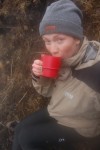 Many families along Iceland’s fertile southern coast can spin a good yarn about a close escape from an exploding volcano. Take Kristín Vogförð’s grandfather, who was tending sheep on the eastern slopes of Katla when it erupted in 1918, melting glacial ice and violently flooding the rivers and fields below. According to an account by the geophysicist from the Icelandic Meteorological Office (IMO), he and the other shepherds rode their tough Icelandic horses through icy waters to safety. Unfortunately, his sheep were not so lucky.
Many families along Iceland’s fertile southern coast can spin a good yarn about a close escape from an exploding volcano. Take Kristín Vogförð’s grandfather, who was tending sheep on the eastern slopes of Katla when it erupted in 1918, melting glacial ice and violently flooding the rivers and fields below. According to an account by the geophysicist from the Icelandic Meteorological Office (IMO), he and the other shepherds rode their tough Icelandic horses through icy waters to safety. Unfortunately, his sheep were not so lucky.
In April, I joined a group of Icelandic volcano experts on a field trip to study rocks, gases and river runoff from Eyjafjallajökull. I witnessed modern escapes and came away impressed by how much Iceland’s scientists are doing to learn all they can from the latest eruptions, which have already begun to take a large toll on the small country’s tourism and agriculture industries.
Read the rest of my essay for Global Talent, a Catalan science service, in English [html] [pdf], Spanish [html] [pdf], or Catalan [html] [pdf].